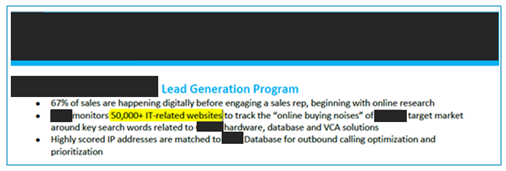- November 9, 2015
- Demand Generation
Marketers Beware: Not All Purchase Intent Data is Created Equal
 New technologies are a great thing. Often they lead to new ways to approach issues and can be disruptive as well as additive to success. They lead to new and innovative ways to accomplish goals and tasks. However, with new technologies there’s also a level of unknown and an initial learning curve that needs to ensue where our lack of knowledge during this period leaves us as prey and puts us in the position where we can be taken advantage of. When we hear improbable claims in our personal lives we immediately question what the reality of the claim is.
New technologies are a great thing. Often they lead to new ways to approach issues and can be disruptive as well as additive to success. They lead to new and innovative ways to accomplish goals and tasks. However, with new technologies there’s also a level of unknown and an initial learning curve that needs to ensue where our lack of knowledge during this period leaves us as prey and puts us in the position where we can be taken advantage of. When we hear improbable claims in our personal lives we immediately question what the reality of the claim is.
With the ‘intent’ data evolution it appears to me that folks are enamored with volume because this is all still mainly unknown and certain vendors may be preying on you. And while a lot of new solutions have value, marketers need to be very careful with what they don’t know vs. believing the story being positioned by some vendors in the marketplace.
Take a closer look and see what’s wrong with this picture
I want to share this below – out of respect I’ve removed the select vendor. To be clear, this is from an actual media proposal from an ‘intent’ vendor that claims that they monitor 50,000 IT related websites. What’s wrong with this picture?

- Let’s call a spade a spade. How likely is it that there are 50,000 targeted, B2B IT related websites in the world?
- Of these 50,000, I’d be very curious to have this vendor quantify how many of this bundle are consumer and generic news outlets. Can they quantify the bulk of sites where they’re pulling data from? How about illustrate content within, across and by scale that would be relevant to someone actually creating a shortlist?
- Keep in mind context and relevance with your solutions. This proposal was for a vendor who sells hardware solutions – servers. So of these supposed 50,000 ‘IT’ related websites, how many actually cover hardware technology with authority?
The reality is that there are a handful of key sites on the web that are specific to 1) IT and 2) where folks actually go to research when they’re looking at complex solution purchases. It’s these sites that have the best intent data. If a vendor makes claims such as monitoring 50,000 IT related websites, you need to dig deeper with them to see if that is truly the case. Don’t be afraid to ask your data providers tough questions.
Yes, you need breadth to capture a wide enough signal base to achieve a data set of value. But rather than focus on volume, focus on relevance:
- Any vendor that claims to model intent data should be able to show and share relevant communities they’re pulling audience intent from. If they can’t – run away and run away fast. If they do, great – make sure that the sites are covering your topics and pay attention to the content. If it’s not content that you’d use to research for a solution or project it’s not relevant content for the audience you’re looking to reach.
- A number of studies have shown that 90+% of clicks come from the first page of results on Google so if you’re finding intent providers sites populate directly in the research path even better. Just remember that if it’s not that relevant to the user it’s therefore not that relevant to you.
Be Informed
Embrace the change as intent solutions are going to empower marketing like never before – but don’t get taken for a ride. No one monitors the entire web. Volume isn’t indicative of the right signals. Do your own due diligence because remember, intent offerings are only as good as what they model from.
Data scale image source: OdinText
Intelligence Driven Marketing, marketing intelligence, purchase intent data



